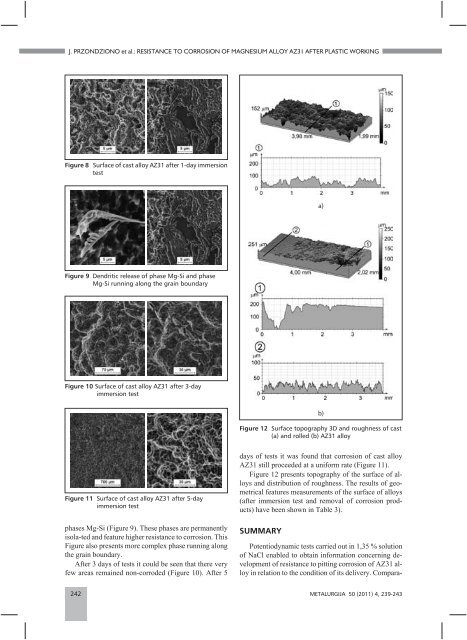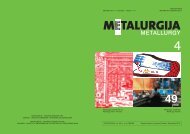PDF - 2453 kB - CARNet
PDF - 2453 kB - CARNet
PDF - 2453 kB - CARNet
You also want an ePaper? Increase the reach of your titles
YUMPU automatically turns print PDFs into web optimized ePapers that Google loves.
J. PRZONDZIONO et al.: RESISTANCE TO CORROSION OF MAGNESIUM ALLOY AZ31 AFTER PLASTIC WORKING<br />
Figure 8 Surface of cast alloy AZ31 after 1-day immersion<br />
test<br />
Figure 9 Dendritic release of phase Mg-Si and phase<br />
Mg-Si running along the grain boundary<br />
Figure 10 Surface of cast alloy AZ31 after 3-day<br />
immersion test<br />
Figure 11 Surface of cast alloy AZ31 after 5-day<br />
immersion test<br />
phases Mg-Si (Figure 9). These phases are permanently<br />
isola-ted and feature higher resistance to corrosion. This<br />
Figure also presents more complex phase running along<br />
the grain boundary.<br />
After 3 days of tests it could be seen that there very<br />
few areas remained non-corroded (Figure 10). After 5<br />
Figure 12 Surface topography 3D and roughness of cast<br />
(a) and rolled (b) AZ31 alloy<br />
days of tests it was found that corrosion of cast alloy<br />
AZ31 still proceeded at a uniform rate (Figure 11).<br />
Figure 12 presents topography of the surface of alloys<br />
and distribution of roughness. The results of geometrical<br />
features measurements of the surface of alloys<br />
(after immersion test and removal of corrosion products)<br />
have been shown in Table 3).<br />
SUMMARY<br />
Potentiodynamic tests carried out in 1,35 % solution<br />
of NaCl enabled to obtain information concerning development<br />
of resistance to pitting corrosion of AZ31 alloy<br />
in relation to the condition of its delivery. Compara-<br />
242 METALURGIJA 50 (2011) 4, 239-243<br />
a)<br />
b)

















